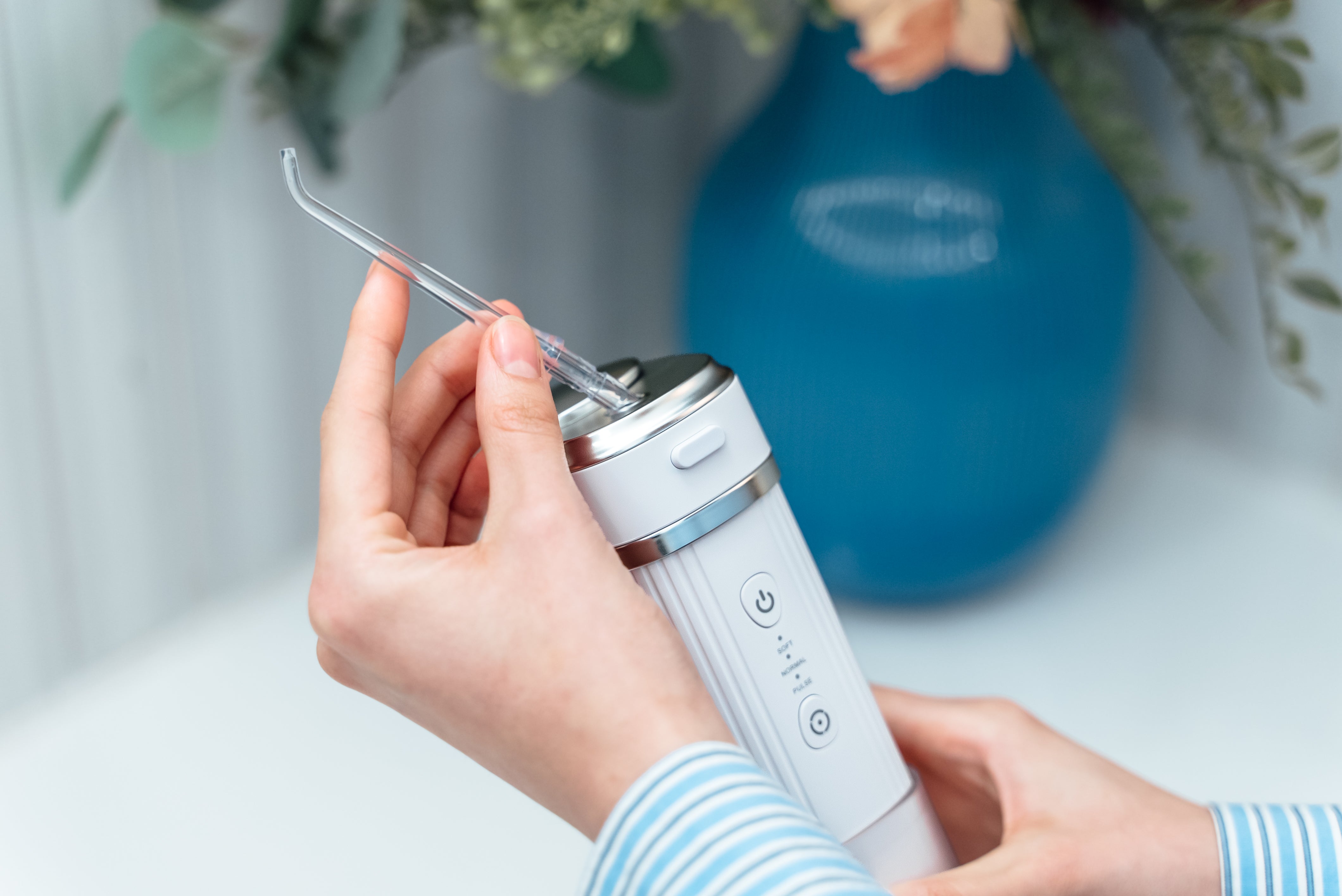Svarstai, ką rinktis – soninį ar osciliuojantį šepetėlį? Problema ta, kad kiekvienas turi savo privalumų – pirmasis yra švelnus dantenoms, antrasis turi stipresnį valymo poveikį. O jei visai nereikia rinktis?
TAIP PAT ŽIŪRĖK: Kokios sveikatos naudos gaunamos reguliariai naudojant soninį dantų šepetėlį?
SoniQ+ soninis-rotacinis šepetėlis su 60° sukamuoju judesiu
Kaip veikia hibridinė technologija?
Šepetėlio galvutė švelniai juda į dešinę ir į kairę, nedarydama pilnų apsisukimų. Dėl to ji valo tiksliai, bet ne taip intensyviai kaip įprasti rotaciniai šepetėliai.
Efektyvi kova su dantų apnašomis
Soninės vibracijos burnoje sukuria seilių mikro sroves, kurios išplauna bakterijas iš sunkiai pasiekiamų tarpdančių vietų. Tuo pačiu švelnūs sukamieji judesiai mechaniniu būdu pašalina įkyrų dantų apnašų sluoksnį nuo dantų paviršiaus. Šis dvigubas poveikis leidžia šepetėliui geriau kovoti su apnašomis nei bet kuri atskira technologija.[1]
Koks soninis dantų šepetėlis bus geriausias tau?
SoniQ+ soninis-rotacinis šepetėlis puikiai tiks, jei:
- turi įvairių problemų (jautrios dantenos + įkyrus apnašas ant dantų),
- ieškai vieno prietaiso visai šeimai (gali keisti antgalius),
- nori pasiekti maksimalų efektyvumą.
Tradicinis elektrinis soninis dantų šepetėlis pakanka jautrioms dantenoms ar lengvam dantų akmeniui, bet hibridinis suteikia daugiau galimybių.[2]
Koks soninis dantų šepetėlis bus geriausias tavo vaikams?
Mažiems vaikams (iki 8 metų) geresni tradiciniai soniniai modeliai. Vyresniems – hibridinis gali būti puikus su ortodontiniais aparatais, dvigubas judesys geriau valo sunkiai pasiekiamas vietas aplink aparatą.[3]
TAIP PAT ŽIŪRĖK: Koks soninis dantų šepetėlis? Geriausių modelių vadovas [...]
SoniQ+ antgaliai – ar tinka įprasti?
Ne. SoniQ+ rotacinis soninis dantų šepetėlis reikalauja specialių antgalių, kurie atlaiko dvigubą judesį. Įprasti soniniai antgaliai gali greitai sugesti.
Soninio dantų šepetėlio naudojimo rezultatai
- Pirmoji savaitė: Pripratimas prie naujo veikimo.
- Antra savaitė: Švaresnis pojūtis tarp dantų.
- Mėnuo: Dantenų pagerėjimas, mažiau kraujavimo.
- Du mėnesiai: Akmens mažinimas, baltesni dantys.
Soninis dantų šepetėlis – kaip naudoti hibridinius modelius?
- Pradėkite atsargiai – pirmą dieną naudokite švelniausią režimą.
- Nespauskite – įrenginys turi du veikimo mechanizmus, spaudimas juos blokuoja.
- Sustokite ilgiau – leiskite veikti 3-4 sekundes vienoje vietoje.
- Klausykite kūno – diskomforto atveju pereikite prie švelnesnio režimo.
ZENT® SoniQ+ – hibridinės technologijos pionierius Lietuvos rinkoje
Lietuvos rinkoje išsiskiria ZENT® SoniQ+ – pirmoji soninė sukamąja judančia dantų šepetėlis, derinanti 31 000 soninių vibracijų su 180 oscilacijų per minutę. Dėl Dual-Motion technologijos užtikrina efektyvų apnašų pašalinimą išlaikant švelnumą. Įrenginys siūlo 5 darbo režimus ir veikia iki 30 dienų vienu įkrovimu.
Dažniausiai užduodami klausimai apie Sonic-rotacinius dantų šepetėlius
- Ar hibridinis šepetėlis yra garsesnis? Šiek tiek garsesnis už Sonic, bet tyliau nei rotaciniai.
- Kiek laiko trunka priprasti? 3–5 dienos.
- Kiek kainuoja? 200–600 zł.
- Ar tinka implantams? Taip, jis rekomenduojamas.
Sonic-rotacinis dantų šepetėlis yra sprendimas tiems, kurie nenori rinktis tarp švelnumo ir efektyvumo. Jis sujungia Sonic ir rotacinės technologijos privalumus, siūlydamas tikslų valymą be dirginimo. Ypač tinka įvairioms burnos higienos problemoms ir kaip universalus įrenginys visai šeimai.
TAIP PAT ŽIŪRĖKITE: Kaip išsirinkti geriausią dantų šepetėlių sterilizatorių?
NUORODOS:
-
Grender J ir kt. Vertinimas osciluojančio-sukančio dantų šepetėlio su mikrovirpesiais ir Sonic dantų šepetėlio plokštelės ir gingivito mažinimui: atsitiktinių imčių kontroliuojamo tyrimo rezultatai. International Dental Journal. 2020.
-
Grender J ir kt. Meta-analizė, lyginanti dantų šepetėlių technologijas gingivito ir plokštelės atžvilgiu. International Dental Journal. 2023.
-
Aarthi K ir kt. Elektrinių, rankinių ir Sonic dantų šepetėlių plokštelės šalinimo efektyvumo palyginamoji analizė vaikams nuo 6 iki 12 metų: atsitiktinių imčių kontroliuojamas tyrimas. Journal of Neonatal Surgery. 2025.







